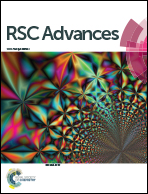Electrical impedance monitoring of protein unfolding
Abstract
We have applied electrical impedance spectroscopy (EIS) to investigate how the dielectric characteristics of protein aqueous solutions respond to varying amounts of a co-dissolved surfactant. Using bovine serum albumin (BSA) as our model system, we followed the conformational changes of the protein molecules that result from the progressive increment in the concentration of either ionic (sodium dodecyl sulfate – SDS, and dodecyltrimethylammonium bromide – DTAB) or non-ionic (Triton X-100) surfactants, and modeled the corresponding electrical response through a modified Randles circuit. From the dielectric data, we selected the behavior of the passive layer resistance (RPL) as a convenient parameter to map the conformational changes in the BSA molecules. The profile of the dielectric response of the BSA–surfactant solutions as a function of the amount of the added surfactant allows the identification of different ranges of the detergent relative concentration that can be associated to each one of the successive regimes of the surfactant–protein interaction. These results were similar to those obtained from a standard Stern–Volmer analysis of the fluorescence emission of the protein chain, with a better agreement occurring in the case of the non-ionic surfactant. We propose this novel EIS approach as a convenient alternative methodology to follow conformational changes of weakly fluorescent proteins.



 Please wait while we load your content...
Please wait while we load your content...